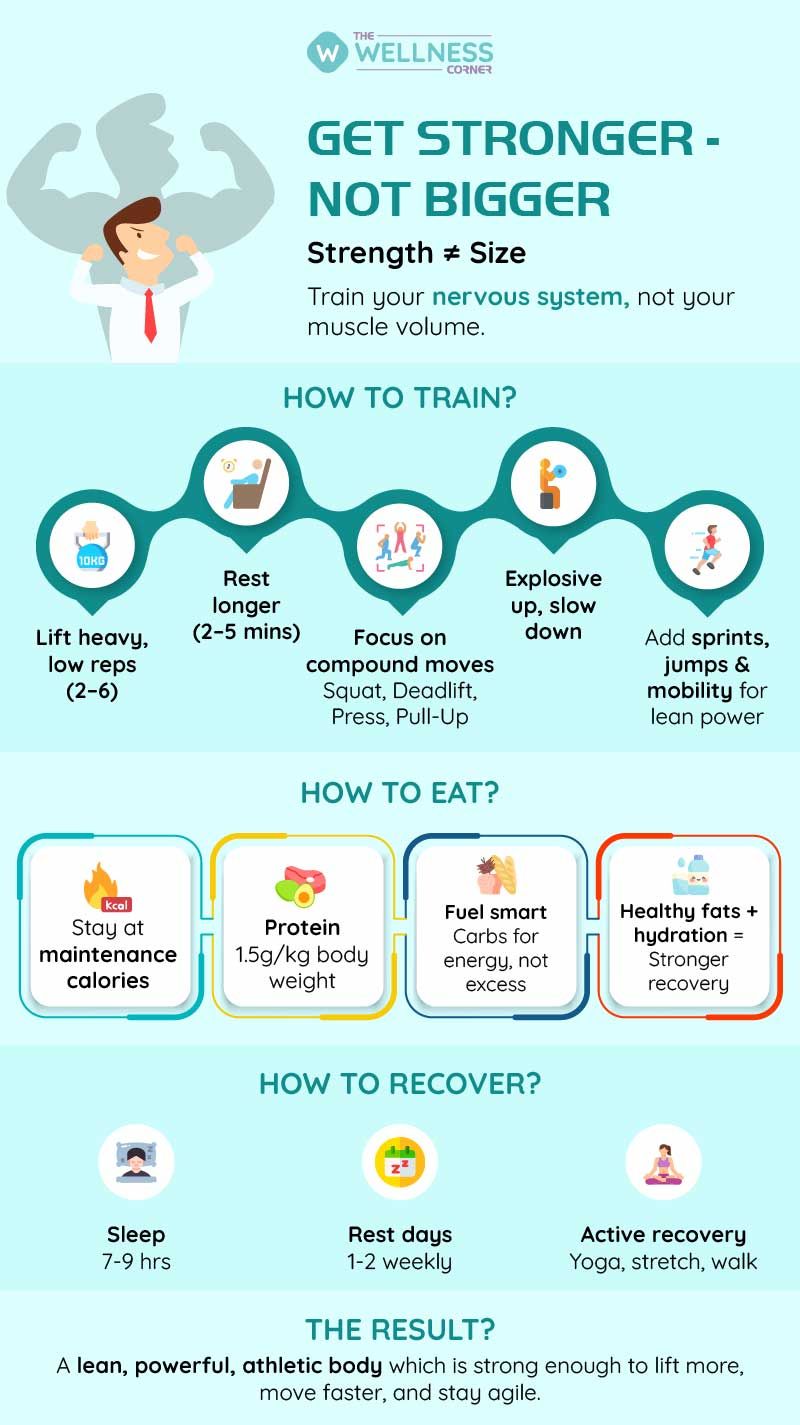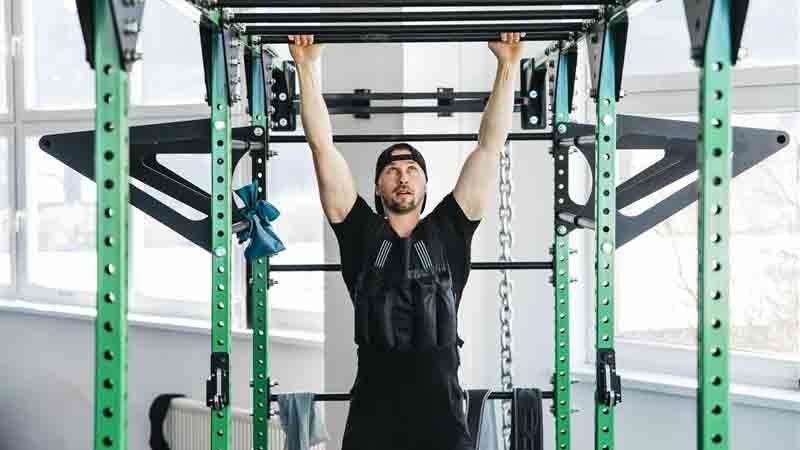How To Get Stronger Without Getting Bigger (In Size)?
- 1 month ago
When you think about strength training, you might immediately picture bodybuilders with large, bulky muscles. But not everyone trains for size. Some people want to be strong without looking bigger—like athletes who need speed and agility, professionals who prefer a lean look, or fitness enthusiasts who want strength for everyday life.
The good news? You can definitely get stronger without adding a lot of muscle mass. It all comes down to the way you train, the way you fuel your body, and the way you recover. In this article, we’ll explore the science behind strength without bulk, the training methods that work best, and practical steps you can start today.

Strength vs. Size: What’s The Difference?
It’s easy to assume strength and size go hand in hand, but they’re not the same thing.
- Strength is your ability to produce force. For example, being able to deadlift twice your bodyweight.
- Size (hypertrophy) is the physical growth of muscle fibers, leading to larger-looking muscles.
You can build strength by training your nervous system to activate and use more muscle fibers effectively. This process is called neural adaptation—your brain and nervous system simply get better at “activating” the muscles you already have. That’s how powerlifters and athletes can move massive weights without looking huge.
Training For Strength Without Bulk
If you want to build strength but not size, the way you structure your workouts is crucial.
1. Focus On Low Reps, High Intensity
Muscles grow best in the 8–12 rep range with moderate weights and short rest times. To avoid this:
- Train with heavier weights (80–90% of your one-rep max)
- Perform 2–6 reps per set
- Rest 2–5 minutes between sets
This lets you train your nervous system for power without giving your muscles the volume needed to grow much bigger.
Also Read: 4 Things You Wish You Knew Before Starting Lifting Weights
2. Prioritize Compound Movements
Compound exercises are the foundation of strength training. They recruit multiple muscle groups at once, making them perfect for building functional strength:
- Squats – Build stronger legs and enhance core stability.
- Deadlifts – Develop total body power
- Bench Press – Strengthens chest, shoulders, and triceps
- Overhead Press – Builds shoulder and upper-body strength
- Pull-Ups/Chin-Ups – Enhance back and arm pulling power
- Barbell Rows – Improve posture and pulling strength
These lifts allow you to load heavier weights safely and efficiently, which is the key to strength gains.
Also Read: Should I Do Deadlifts Or Squats First?
3. Keep Volume Low To Moderate
Muscle growth depends heavily on training volume (sets × reps × weight).
- For strength, stick to 3–5 sets per exercise
- Avoid marathon workouts with 6–7 accessory lifts for the same muscle group
- Keep your total workout under 60–75 minutes
This way, you stimulate your nervous system for strength but don’t accumulate enough volume for hypertrophy.
4. Lift With Controlled Speed
How you lift affects your results:
- Explosive on the way up (concentric phase) – Train your muscles to fire quickly and efficiently.
- Controlled on the way down (eccentric phase) – Build stability without extra growth.
This keeps the focus on power output instead of prolonged muscle tension (which encourages growth).
5. Mix In Speed, Agility, and Mobility Work
Strength is not just about grinding through heavy lifts; it’s about being strong in motion. Adding variety ensures you’re functional, fast, and lean:
- Sprints (short bursts, 20–60 meters) for explosive power
- Plyometrics (box jumps, broad jumps, clap push-ups) for speed-strength
- Agility drills (ladder runs, cone shuffles) for athleticism
- Mobility work (dynamic stretches, yoga flows) to keep joints healthy and prevent stiffness
A Sample Strength-Focused Training Plan
Here’s a simple 3-day per week program designed for strength without bulk:
Day 1 – Lower Body
- Squats: 4×4 (heavy, low reps)
- Deadlifts: 3×3
- Bulgarian Split Squats: 3×5 (each leg)
- Sprints: 6×40 meters
Day 2 – Upper Body
- Bench Press: 4×4
- Pull-Ups (weighted if possible): 4×5
- Overhead Press: 3×5
- Barbell Rows: 3×5
- Clap Push-Ups: 3×8
Day 3 – Full Body/Power
- Power Cleans: 4×3
- Front Squats: 3×5
- Push Press: 3×4
- Box Jumps: 5×6
- Farmer’s Carry: 4×30 seconds
Nutrition: Stay Strong, Not Big
Your diet decides whether your muscles grow bigger or just get stronger. To avoid size gains:
1) Eat at Maintenance Calories
- Don’t eat in a calorie surplus. Extra calories = muscle growth (and sometimes fat gain).
- Track your intake to stay around the maintenance level.
2) Protein Is Essential
- Aim for 1.5 g of protein per kg of body weight daily
- Sources: chicken, eggs, fish, lentils, beans, paneer, tofu
Also Read: How To Tell If You're Not Getting Enough Protein: 10 Key Indicators
3) Fuel With Carbs For Performance
- Have carbs (like rice, oats, fruit) before training for energy
- But don’t overdo it if you’re not training intensely
4) Healthy Fats For Hormone Balance
Nuts, seeds, avocados, ghee, and olive oil support faster recovery and enhance overall health.
5) Hydrate Properly
- Strength output drops quickly if you’re dehydrated.
- Drink water consistently throughout the day.
Recovery: The Overlooked Strength Secret
Strength training challenges not just your muscles but also your nervous system. Without recovery, you’ll stall or risk injury.
- Sleep 7–9 hours: Deep sleep is where recovery and strength adaptation happen. Make sure to give yourself 1–2 complete rest days each week.
- Active Recovery: Yoga, stretching, walking, or light cycling keeps your body fresh.
- Avoid Overtraining: Listen to your body—fatigue, irritability, and poor performance are signs you need rest.

Who Benefits From This Approach?
This method isn’t just for athletes. It’s great for:
- Martial artists and sprinters who need explosive power but can’t afford extra bulk.
- Climbers and gymnasts benefit from the strength-to-weight ratio.
- Professionals who want strength for daily life without a “bulky” look.
- Fitness enthusiasts who prefer a lean, athletic physique.
Final Thoughts
Getting stronger doesn’t mean you have to get bigger. By training with low reps, heavy weights, and longer rest, focusing on compound lifts, and controlling your nutrition and recovery, you can build impressive strength while keeping a lean, athletic body.
Strength is more than muscle—it’s about power, control, and efficiency. With the right approach, you can move heavier weights, feel more capable, and stay lean without adding unnecessary size.








